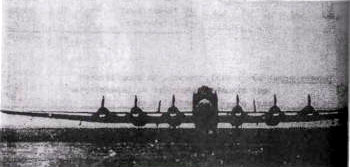Nazi transatlantic bombers
Wednesday, June 11th, 2008Adolf Hitler always understood that his primary enemy was the United States. Ultimately, the Nazi plan was to harness the resources of Europe—and in particular those of European Russia—under the aegis of a new superstate, with Germany at its core. England and France would get the hell out of the way, or be roadkill. And then the full industrial might of the Third Reich could be turned against America.
An idea that gets all the scarier when you consider what was on the drawing boards. Inevitably, as the conflict with England and Russia deepened, Germany channeled its bomber production into tactical bombers. But behind the scenes, plans for some true behemoths were underway.
The most favored design among the Nazi planners is shown here.  You’re looking at the Junkers 390, a six-engined monstrosity capable of flying all the way to New York and then returning to Berlin for a round of schnapps. In fact, there are (admittedly unconfirmed) reports that this thing did exactly that in 1944 on a dry run, turning back even as its crew saw the lights of Manhattan emerging over the horizon. No prizes for guessing what kind of bombing run they were training for: by that point in the war, with the Reich collapsing around Hitler’s ears, there was really only one reason to try to hit New York, and that was with an atomic weapon. Fortunately, the German atomic program was way behind by that point, so it all came to naught.
You’re looking at the Junkers 390, a six-engined monstrosity capable of flying all the way to New York and then returning to Berlin for a round of schnapps. In fact, there are (admittedly unconfirmed) reports that this thing did exactly that in 1944 on a dry run, turning back even as its crew saw the lights of Manhattan emerging over the horizon. No prizes for guessing what kind of bombing run they were training for: by that point in the war, with the Reich collapsing around Hitler’s ears, there was really only one reason to try to hit New York, and that was with an atomic weapon. Fortunately, the German atomic program was way behind by that point, so it all came to naught.
 But the Ju-390 was just the tip of the iceberg. The ultimate goal was to build a strategic bomber that had jets. The strongest contender was a Horten flying wing: it’s NOT the craft shown here, which was an earlier design. The Horten XVIIIB would have had twice the wingspan of the thing you’re looking at now. Had Hitler knocked Russia out of the war, we’d have been facing a whole fleet of these.
But the Ju-390 was just the tip of the iceberg. The ultimate goal was to build a strategic bomber that had jets. The strongest contender was a Horten flying wing: it’s NOT the craft shown here, which was an earlier design. The Horten XVIIIB would have had twice the wingspan of the thing you’re looking at now. Had Hitler knocked Russia out of the war, we’d have been facing a whole fleet of these.
And we’d have been up against bona fide SPACECRAFT as well. I’m not even referring to whatever the successors to the V2 rocket would have been. I’m talking about the Sanger spaceplane, which was intended to be put on the back of a rocket sled. Once the sled accelerated to a sufficient speed, the spaceplane would have been launched off the back of it. It would have gone suborbital, bombed New York, and then, instead of turning around, continued on into the Pacific where a German (or Japanese) U-boat would have picked up both crew and vehicle.
I’m not even referring to whatever the successors to the V2 rocket would have been. I’m talking about the Sanger spaceplane, which was intended to be put on the back of a rocket sled. Once the sled accelerated to a sufficient speed, the spaceplane would have been launched off the back of it. It would have gone suborbital, bombed New York, and then, instead of turning around, continued on into the Pacific where a German (or Japanese) U-boat would have picked up both crew and vehicle.
None of these planes was ever put to the test in a live bombing run. But all of them became fodder for the Russians and the Americans at the end of the war, as the race to capture German scientists intensified and the allies fell out among themselves and a new competition took shape. One that we should be thankful for. Who would we rather have faced in the late 1940s, an exhausted Soviet Union or a Nazi Germany that was busy consolidating its hold over Europe and turning its eyes over the Atlantic? In a sense, the big might-have-been of World War II is that, had it taken a different direction, it might have led to the first space war.
And speaking of space wars, I’m planning on publishing in its entirety my essay NOTES TOWARD A THEORY OF SPACE-CENTRIC WARFARE, written from the perspective of the year 2110. I’ve already posted the first part HERE, and intend to serialize the rest across the next few days/weeks. So watch this space.




